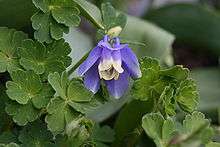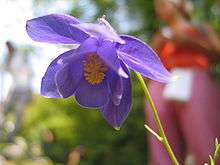Aquilegia
| Columbine | |
|---|---|
| | |
| flower and fruit of Aquilegia vulgaris (type species) | |
| Scientific classification | |
| Kingdom: | Plantae |
| (unranked): | Angiosperms |
| (unranked): | Eudicots |
| Order: | Ranunculales |
| Family: | Ranunculaceae |
| Subfamily: | Thalictroideae |
| Genus: | Aquilegia L. |
| Species | |
|
60-70, see text | |
Aquilegia (common names: granny's bonnet or columbine) is a genus of about 60-70 species[1] of perennial plants that are found in meadows, woodlands, and at higher altitudes throughout the Northern Hemisphere, known for the spurred petals [2] of their flowers.
Etymology
The genus name Aquilegia is derived from the Latin word for eagle (aquila), because the shape of the flower petals, which are said to resemble an eagle's claw. The common name "columbine" comes from the Latin for "dove", due to the resemblance of the inverted flower to five doves clustered together.[3]
Description
The fruit is a follicle.[4] the five points that stick out further than the petals are the calyx (chalis).
Relatives
Columbines are closely related to plants in the genera Actaea (baneberries) and Aconitum (wolfsbanes/monkshoods), which like Aquilegia produce cardiogenic toxins.[5]
Insects
They are used as food plants by some Lepidoptera (butterfly and moth) caterpillars. These are mainly of noctuid moths – noted for feeding on many poisonous plants without harm – such as Cabbage Moth (Mamestra brassicae), Dot Moth (Melanchra persicariae) and Mouse Moth (Amphipyra tragopoginis). The Engrailed (Ectropis crepuscularia), a geometer moth, also uses columbine as a larval foodplant.
Plants in the Aquilegia genus are a major food source for Bombus hortorum, a species of bumblebee. Specifically, they have been found to forage on species of Aquilegia vulgaris in Belgium and Aquilegia chrysantha in North America and Belgium. The bees do not show any preference in color of the flowers.[6]
Cultivation

Columbine is a hardy perennial, which propagates by seed. It will grow to a height of 15 to 20 inches. It will grow in full sun; however, it prefers growing in partial shade and well drained soil, and is able to tolerate average soils and dry soil conditions. Columbine is rated at hardiness zone 3 in the USA so does not require mulching or protection in the winter.[7][8]
Large numbers of hybrids are available for the garden, since the European A. vulgaris was hybridized with other European and North American varieties. [9] Aquilegia species are very interfertile, and will self-sow.[10] Some varieties are short-lived so are better treated as biennials. The following hybrid cultivars have gained the Royal Horticultural Society's Award of Garden Merit:
The British National Collection of aquilegias is held by Mrs Carrie Thomas at Killay near Swansea.[18]
Uses
The flowers of various species of columbine were consumed in moderation by Native Americans as a condiment with other fresh greens, and are reported to be very sweet, and safe if consumed in small quantities. The plant's seeds and roots are highly poisonous however, and contain cardiogenic toxins which cause both severe gastroenteritis and heart palpitations if consumed as food. Native Americans used very small amounts of Aquilegia root as a treatment for ulcers. However, the medical use of this plant is better avoided due to its high toxicity; columbine poisonings may be fatal.[5]
An acute toxicity test in mice has demonstrated that ethanol extract mixed with isocytisoside, the main flavonoid compound from the leaves and stems of Aquilegia vulgaris, can be classified as non-toxic, since a dose of 3000 mg/kg did not cause mortality.
Culture
The Colorado Blue Columbine (A. caerulea) is the official state flower of Colorado (see also Columbine, Colorado).
Evolution
Columbines have been important in the study of evolution. It was found that the Sierra columbine (A. pubescens) and crimson columbine (A. formosa) each have adapted specifically to a pollinator. Bees and hummingbirds are the visitors to A. formosa, while hawkmoths would only visit A. pubescens when given a choice. Such a "pollination syndrome", being due to flower color and orientation controlled by their genetics, ensures reproductive isolation and can be a cause of speciation.[19]
Aquilegia petals show an enormous range of petal spur length diversity ranging from a centimeter to the 15 cm spurs of Aquilegia longissima. Selection from pollinator shifts is suggested to have driven these changes in nectar spur length.[20] Interestingly, it was shown that this amazing spur length diversity is achieved solely through changing cell shape, not cell number or cell size. This suggests that a simple microscopic change can result in a dramatic evolutionarily relevant morphological change.[2]
Species
_02.jpg)





Columbine species include:[21]
|
|
See also
Footnotes
- ↑ Sunset Western Garden Book, 1995:606–607
- 1 2 Puzey, J.R., Gerbode, S.J., Hodges, S.A., Kramer, E.M., Mahadevan, L. (2011) Evolution of Aquilegia spur length diversity through changes in cell anisotropy. Proceedings of the Royal Society B.
- ↑ Shorter Oxford English dictionary, 6th ed. United Kingdom: Oxford University Press. 2007. p. 3804. ISBN 0199206872.
- ↑ Dezhi & Robinson (2001)
- 1 2 Tilford (1997)
- ↑ Macior, Lazarus Walter (1966-03-01). "Foraging Behavior of Bombus (Hymenoptera: Apidae) in Relation to Aquilegia Pollination". American Journal of Botany. 53 (3): 302–309. doi:10.2307/2439803. JSTOR 2439803.
- ↑ The Gardener's Network
- ↑ John Kilmer (1989). The Perennial Encyclopedia ISBN 0-88665-639-7
- ↑ Andrew McIndoe, Kevin Hobbs: Perennials. David & Charles, 2005 ISBN 1-55870-764-6 ISBN 978-1-55870-764-1
- ↑ New England Wild Flower Society Guide to Growing and Propagating Wildflowers of the United States and Canada
- ↑ "RHS Plant Selector - Aquilegia 'Bluebird'". Retrieved 11 June 2013.
- ↑ "RHS Plant Selector - Aquilegia 'Bunting'". Retrieved 11 June 2013.
- ↑ "RHS Plant Selector - Aquilegia 'Dove'". Retrieved 11 June 2013.
- ↑ "RHS Plant Selector - Aquilegia 'Florida'". Retrieved 11 June 2013.
- ↑ "RHS Plant Selector - Aquilegia 'Louisiana'". Retrieved 11 June 2013.
- ↑ "RHS Plant Selector - Aquilegia 'Origami Red and White'". Retrieved 11 June 2013.
- ↑ "RHS Plant Selector - Aquilegia 'Origami Rose and White'". Retrieved 11 June 2013.
- ↑ "Plant Heritage - National Collections Scheme, UK Garden Plants". Nccpg.com. Retrieved 2014-05-30.
- ↑ Fulton & Hodges (1999), Hodges et al. (2002)
- ↑ Whittall, Justen B.; Hodges, Scott A. (7 June 2007). "Pollinator shifts drive increasingly long nectar spurs in columbine flowers". Nature. 447 (7145): 706–709. doi:10.1038/nature05857. PMID 17554306.
- ↑ Dezhi & Robinson (2001), RBGE [2008], USDA [2008]
References
| Wikimedia Commons has media related to Aquilegia. |
| Wikisource has the text of a 1911 Encyclopædia Britannica article about Aquilegia. |
- Allan M. Armitage: Armitage's Native Plants for North American Gardens.Timber Press, 2006 ISBN 0-88192-760-0 ISBN 978-0-88192-760-3
- Dezhi, Fu; Robinson, Orbélia R. (2001): 19. Aquilegia. In: Wu, Z. Y.; Raven, Peter Hamilton & Hong, D. Y. (eds.): Flora of China (Vol. 6: Caryophyllaceae through Lardizabalaceae): 278. Science Press, Beijing & Missouri Botanical Garden Press, St. Louis. ISBN 1-930723-25-3 HTML fulltext
- Fulton, M.; Hodges, S. A. (1999). "Floral isolation between Aquilegia formosa and Aquilegia pubescens". Proceedings of the Royal Society B: Biological Sciences. 266 (1435): 2247–2252. doi:10.1098/rspb.1999.0915.
- Hodges, S. A.; Whittall, J. B.; Fulton, M.; Yang, J. Y. (2002). "Genetics of Floral Traits Influencing Reproductive Isolation between Aquilegia formosa and Aquilegia pubescens". The American Naturalist. 159: S51–S60. doi:10.1086/338372. PMID 18707369.
- Nold, Robert (2003): Columbines: Aquilegia, Paraquilegia, and Semiaquilegia. Timber Press. ISBN 0-88192-588-8 Preview at Google Books
- Royal Botanic Garden Edinburgh (RBGE) [2008]: Digital Flora Europaea: Aquilegia species list. Retrieved 2008-NOV-25.
- Tilford, Gregory L. (1997): Edible and Medicinal Plants of the West. Mountain Press Pub., Missoula, Montana. ISBN 0-87842-359-1
- United States Department of Agriculture (USDA) [2008]: USDA Plants Profile: Aquilegia. Retrieved 2008-NOV-25.
- Puzey, J. R.; Gerbode, S. J.; Hodges, S. A.; Kramer, E. M.; Mahadevan, L. (2011). "Evolution of spur-length diversity in Aquilegia petals is achieved solely through cell-shape anisotropy". Proceedings of the Royal Society B: Biological Sciences. doi:10.1098/rspb.2011.1873.
Related reading
- Kramer, E. M. (2009). Aquilegia: A New Model for Plant Development, Ecology, and Evolution Annual Review of Plant Biology, Vol. 60.